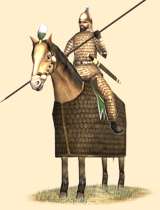Aznvakan Aspet (Armenian Noble Cataphracts)
 |
Weapons | Defence | Mental | ||||||
|---|---|---|---|---|---|---|---|---|---|
| Primary | Secondary | Armour: | 18 | Morale: | 16 | ||||
| Type: | spear | mace | Shield: | 0 | Discipline: | disciplined | |||
| Attack: | 5 | 10 | Skill: | 13 | Training: | highly_trained | |||
| Charge: | 37 | 18 | Recruitment | Other | |||||
| Lethality: | 0.4 | 0.165 | Soldiers: | 25 | Hit Points: | 1 | |||
| Range: | 0 | 0 | Cost: | 4457 | Mass: | 1 | |||
| Ammo: | 0 | 0 | Upkeep: | 1114 | |||||
| Turns: | 1 | ||||||||

The Naharar are the elite household guard of the Armenian kings. Loyal unto death, they are a formidable warrior elite dedicated to the defense of their king.
Elite
Disciplined
Hardy
These Armenian Heavy Cavalry are disciplined, aggressive and capable. The Armenian cavalry was well known for its valor and these heavily armoured Cataphracts are no exception. Using lance and mace these horsemen are a formidable force on the field of battle. The standard equipment of the Armenian cataphracts would have included an old style conical Assyrian helmet of iron with a scale aventail. They would have an iron scale corselet protecting the torso. Complete laminated (bands) arm guards would emerge from the shoulder, encasing the arms down to the wrist. Leather gauntlets reinforced with mail would be worn to protect the hands. Thigh guards and leg defenses of scale armour attached to quilted cuisses secured to the belt with leather thongs. A heavily embroidered saddle cloth would be used.
Historically, the Armenian Royal Cataphract Cavalry are recruited from the Nakharars, the high nobility of Armenia and these men are the armoured fist of Hayastan. The tactical use of armoured lancers in conjunction with horse archers was one of many the things that Parthia and Armenia shared. Such tactics were later used by Tigran and the Armenian cavalry, against the Romans. Sallustius Crispus wrote that in the Armenian army in particular the regiments of horsemen were 'remarkable by the beauty of their horses and armor'. Xenophon mentions the finely bred Armenian horse which he says was smaller than the Persian type. This seems to describe the horse now referred to as the 'Caspian' horse which has been recently recognized in Iran as an ancient breed. Although, only about 12 hands in height, when compared with the images of early Persian horses, it has the same small ears, prominent forehead and cheekbones and large nostrils.